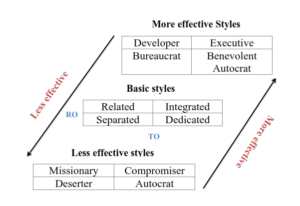6. Tri-dimensional Grid
Reddin conceptualized a three-dimensional grid, also knows as 3-D management, with some ideas taken from the managerial grid. Three dimensional axes represents task-orientation, relationship orientation and effectivenss.
By adding an effectiveness dimension to the task oriented and relationship oriented behavior dimensions, Reddin has integrated the concept of leadership styles with the situational demand of a specific environment.
Task orientation
It is the extent to which manger directs his subordinate’s efforts towards goal attainment. It is characterized by planning, organizing and controlling.
Relationship orientation
It is defined as the extent towhich a manager has personal relationships. It is characterized by mutual trust, respect for subordiante’s ideas and suggestions, and their feelings.
Effectiveness
It is defiend as the extent to which a manager is successful in his osition. When the style of theleader is appropriate to a given situation, it is termned as effective, when the style is inappropriate to a given situation,it is termed as ineffective.
Thus, the difference between effective and ineffective styles is often not the actual behavior but the appropriateness of the behavior to the environment in which it is used.
Either degree of Task orientation or relationship orientation or a combination of both,is used by leaders. On this basis, basically there aree four styles as shown below:
These four styles represent four basic types of behavior. The integrated manager gets himself and his people involved with the organsiaiton. There is free two way communication and strong identification and emphasis on teamwork.
Dedicated manager is domineering, interested only in production, ad does not identify with subordinates. He cannot work without power.
The related manager accepts others as he finds them, does not wory about time, sees the organsiatioan as a social system, likes to work with others and obtains cooperation of others by setting examples.
The separated manager is concerned with correcting deviations. He writes rules and policies and enforces them.
Any of these styles can be effective in some situations but not in others. Thus, each o ne of these styles has a less effective as well as a more effective equivalent as shown in the following figure.
Thus, the four styles results into eight styles. These eight styles results from the eight possible combinations of task orientation, relationship orientation and effectivenss as shown in the figure.
The effective styles are:
i. Deserter
He has both low task and low people orientation and is completely altered from organisational life, avoids involvement, does not want to take responsibility and has low commitment, and believes in minimal output and works to rule.
ii. Missionary
He shows only interest in harmony, believes in easy life, avoids conflicts, and does not take initiative. His objectives is to keep his colleagues, subordinates and superior happy.
iii. Autocrat
He is concerned with only the immediate jobs and has no concern for others, his decisions are unilateral and centralized, believes in suppressing and demands obedience of authority, relies more negative motivation.
iv. Compromiser
He uses a high task and relationship-orientation in a situation that may not require a high concentration in either, is a poor decision decision maker and avoids decisions. Is weak and yielding allows various pressures in the situation to influence him too much.
The four corresponding effective styles are as follows:
i. Bureaucrat
He has high orientation towards organisational rules and regulations, is impersonal and less task and relationship-orientation, produces only few ideas and does not take initiative.
ii. Developer
He tends to display implicit trust in people, relies on high relationships-orientation and less task-orientation believes in commitment to work, openness, freedom to act, self-expression and development of subordinates.
iii. Benevolent Autrocrat
He is a directive manager who knows what he wants and often gets it without creating resentment, is high task and less people-orientated, adopts positive economic motivation for getting things done and follows feudalistic approach in managing the organisation.
iv. Executive
He has high task and high relationship – orientation in a situation where such behavior is appropriate, emphasizes team management, task is regarded as interdependent and integrated. The style acts as a powerful motivational instrument in the organisation. This is a democratic leadership style.
The three dimensional model recognizes that a manager may use more than one style, and no single style is suggested to be appropriate in all situations. This gives a clear picture of the managerial world. It is assumed that all the styles have an equal chance of occurring and thus, if sufficiently large number of managers, in a sufficiently diverse number of situations are tested, an equal number of each style would be obtained.

